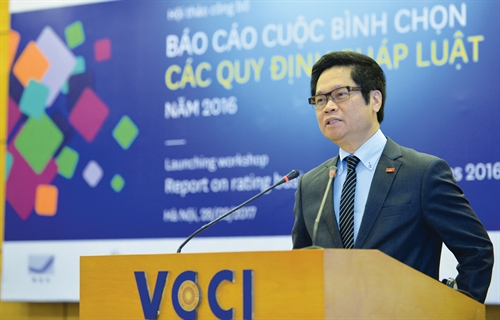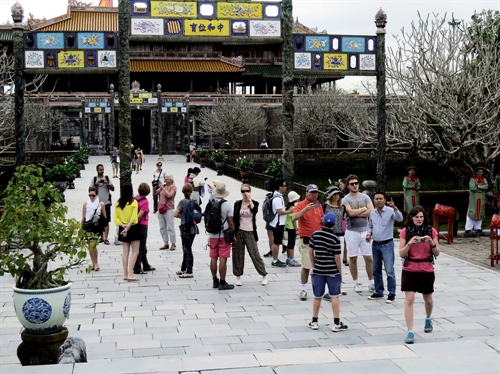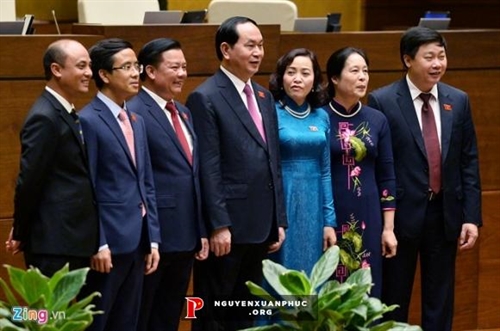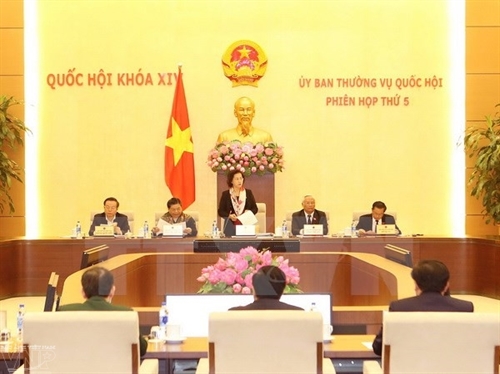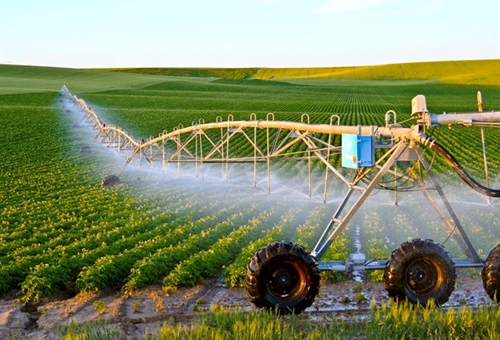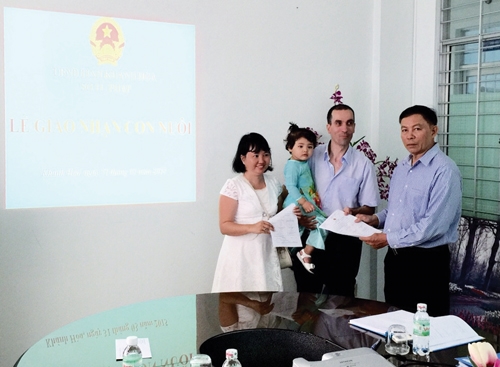Bui Van Thinh, LL.M
Legal Department, General Department of Vietnam Customs
Legal mechanisms to facilitate production, trade and economic connectivity
Vietnam’s restless international integration process requires the creation of appropriate legal mechanisms to facilitate as much as possible production and business activities in order to meet domestic consumption and export demands as well as the transit of international goods in order to earn profits from the international market. These mechanisms have been recognized in Vietnam’s latest Customs Law, passed in 2014, attesting to the Vietnamese State’s policy of creating favorable conditions for import, export, entry, exit and transit activities. With this Law, the nation’s legal environment regarding customs has evolved to accord with the international customs practices.
The above-said legal mechanisms are demonstrated in the following regulations.
Encouraging the application of modern customs declaration methods. The 2014 Customs Law has provisions ensuring the shift from semi-electronic customs declaration to e-customs declaration in most cases. Obviously, e-customs declaration helps cut the time and cost of carrying out customs procedures for both customs declarants and customs offices.
E-customs declaration has been guided in greater detail in Government Decree No. 08/2015/ND-CP dated January 21, 2015 (Decree 08), and Ministry of Finance Circular No. 38/2015/TT-BTC dated March 25, 2015 (Circular 38). Accordingly, e-customs declaration is made through the national single-window portal. Declaration of information, submission of e-documents, decision on customs clearance for imports, exports and goods in transit and receipt of results will all be effected through this portal automatically or with the aid of customs officers.
Promoting the application of the prior identification mechanism. This mechanism has been specified in Decree 08 and Circular 38. It affirms the right of customs declarants to ask the customs office to identify in advance the code, origin, value and price for a type of goods they expect to import. It also stipulates the declarants’ obligation to provide relevant information and documents to the custom office; cases in which their request may be declined; time limit for notification of results; and validity of such notification.
Establishing a more favorable mechanism for priority enterprises. This mechanism has been applied in the field of tax administration. Now, it is clearly stated in the customs law, which applies not only to import and export duty payers but also to other entities carrying out customs procedures. Under this mechanism, enterprises that meet set conditions to be recognized as priority ones by the customs office will enjoy certain incentives when carrying out customs procedures for their imports and exports. These incentives, according to the 2014 Customs Law, include exemption from examination of documents in customs dossiers, exemption from physical inspection of goods; use of temporary declaration forms or commercial invoices for carrying out customs procedures pending availability of official declaration; and priority in carrying out duty-related procedures. These incentives are detailed in Decree 08 and Ministry of Finance Circular No. 72/2015/TT-BTC of May 12, 2015 (Circular 72).
Allowing enterprises to manage processed goods. Previously, management of production of processed goods was only mentioned in the commercial law with respect to various types of goods, such as goods not required to have licenses, goods required to have licenses and goods banned from international trade. Meanwhile, the customs office was tasked to directly manage these processed goods through supervising the norm of materials used for each order and through managing, tracking and inventorying materials leftover after the processing is finished. This task required a lot of time and resources of the customs sector and processing enterprises.
The 2014 Customs Law has introduced a new mechanism allowing enterprises to manage materials and processed products and the customs office to manage only the flow of materials and processed goods from/to the processing-ordering party. Decree 08 and Circular 38 have many provisions detailing this mechanism.
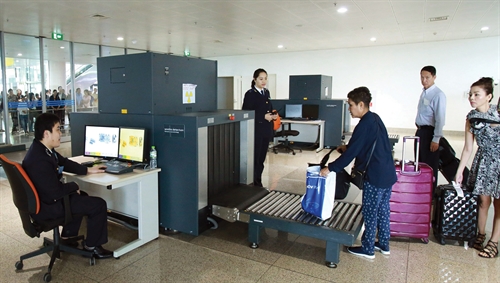 |
| Security-screening luggage of passengers on exit at the Noi Bai International Airport’s Customs Branch__Photo: Hoang Hung/VNA |
Legal mechanisms for further reforming customs procedures
Customs procedures are a type of administrative procedures exclusively applied to the import and export of goods and entry and exit of means of transport at border gates. The purpose of establishment of these procedures is to ensure strict management while avoiding congestion at border gates and minimizing costs of travel, storage and paperwork for enterprises.
With this spirit, the 2014 Customs Law has defined more clearly and transparently types and number of customs procedures, affirming that besides those prescribed by the Law, customs declarants do not have to carry out other administrative procedures. The simplification of customs procedures is also demonstrated in the provisions on specific time limits for carrying out customs procedures, completing customs dossier examination and completing physical inspection of goods, and permitted cases of extension of these time limits.
The Law clearly states that customs procedures are mainly carried out electronically, beginning with the customs declaration, creating a legal basis for application of information technology at a high level in customs management. Article 25 of Decree 08 reaffirms: “Customs declarants shall register for carrying out electronic customs procedures according to regulations issued by the Minister of Finance.” Only in some cases may paper customs declaration be allowed, including imports or exports of border residents; imports or exports in excess of duty-free limits applicable to persons on entry or exit; goods used for emergency relief and humanitarian aid; goods being personal gifts or effects; rotationally used containers of goods according to the mode of temporary import for re-export or temporary export for re-import; goods temporarily imported for re-export or temporarily exported for re-import which are carried along by persons on entry or exit for their work in a certain period of time; and when the e-customs data processing system or e-customs declaration system fails to perform e-transactions between them.
The 2001 Customs Law required five types of documents, namely declaration form; commercial invoice; purchase and sale contract; import or export permit (if any); and other documents as prescribed by law. Meanwhile, the 2014 Customs Law makes uniform general provisions on a custom dossier, no longer requiring purchase and sale contract. However, this type of document may be asked for in specific cases when it is truly needed. Decree 08 enumerates customs dossiers with specified types of document for a number of categories of goods and means of transport, such as goods in transit, re-imported exports, re-exported imports, seagoing ships and aircraft. There are also various circulars specifically providing customs dossiers for other categories of goods.
Noteworthy, the 2014 Customs Law contains specific and clear provisions on places of customs clearance. It distinguishes places of carrying out customs procedures from places of customs inspection, saying the former may be used for customs inspection but not vice versa and places of customs inspection are also places of customs dossier examination and physical inspection of goods. Accordingly, a place of carrying out customs procedures is where the customs office receives, registers and examines customs dossiers and inspects goods and means of transport. It may be the office of the Customs Department or Customs Branch. A place of physical inspection of goods may be at a land border gate, an international rail station, an international airport, an international post office, or a seaport, an inland waterway port with import, export, entry and exit activities; or a cargo import and export port opened in the inland. It may be also at the office of a Customs Branch or a centralized inspection place as decided by the General Director of Customs. Physical inspection of goods may be even carried out at a production establishment or construction site, a trade fair or an exhibition place, and at other places as decided by the General Director of Customs. In a nut shell, Customs dossiers, both electronic or paper, must be received and examined at a customs office, while physical inspection of goods be carried out at a specified site, even a customs office.
Particularly, the 2014 Customs Law states for the first time that at a land border gate a place of joint inspection between Vietnam Customs and the neighboring country’s customs will be established. This aims to ensure the implementation of international agreements on joint customs inspection between neighboring nations.
Reality shows that improper and inconvenient arrangement of places of carrying out customs procedures and places of customs inspection has caused a longer time of customs clearance and inspection. Therefore, reform of customs procedures must be associated with renovation and modernization of infrastructure facilities to ease the performance of customs procedures. For this reason, the 2014 Customs Law requires arrangement of places of customs procedure completion and places of storage of goods in the course of planning, designing or constructing land border gates, international railway stations, international civil airports; seaports and inland waterway ports; inland ports of importation or exportation of goods; economic zones, industrial parks, non-tariff zones and other places with import, export, exit, entry and transit activities. Decree 08 dwells on places of customs clearance and some circulars of the Ministry of Finance give detailed provisions on places of carrying out customs procedures and places of customs inspection to facilitate the management, inspection and storage of goods.
Legal mechanisms for promoting application of modern customs management methods in line with international practices
Reliable and effective modern customs management methods according to international customs practices include applying information technology to the management and customs clearance of imports and exports and means of transport on entry and exit and using modern equipment to inspect and supervise goods and means of transport. Other methods involve prior identification; applying risk management methods; using post-customs clearance inspection to control law compliance; and managing information in a centralized manner by the single-window customs clearance method.
The 2014 Customs Law has fully created legal bases for the application of the above-said methods. Decree 08 clarifies the methods of risk management, classification of imports and exports, prior identification of codes, origin and customs value of goods, and post-customs clearance. Circular 38 and Circular 14/2015/TT-BTC give detailed guidance on the application of these methods.
 |
| Officers of Binh Duong province’s Customs Department answer questions of local import-export enterprises via telephone and website__Photo: Hoang Hung/VNA |
Legal mechanisms for making customs operations more transparent and public
Making transparent and public state management activities is an essential requirement for a modern administrative system. To meet this requirement, the State must make public its activities for its citizens in general and managed and managing subjects in particular to be aware of the position and role of state agencies and of their own in these activities, and of their rights, obligations, responsibilities as well as interests. At the same time, the State must also clearly define the role, position and tasks of related subjects in state management activities.
In line with the above requirement, the 2014 Customs Law has clearly pointed out organizations and persons that are responsible for implementing and applying the Law.
It also sets specific time limits for customs officers to complete their work. For example, examination of customs dossiers must be completed within two working hours from the time of receipt of a dossier; physical inspection of goods must be finished within eight working hours after the goods are presented to the customs office. For goods subject to specialized inspection of quality, food safety or quarantine, the time limit for completing physical inspection will start from the time of receipt of specialized inspection results. For goods of large quantities and numerous types or when their inspection is complicated, heads of customs offices may decide to prolong the time of physical inspection for not more than two days. The Law also requires customs offices to carry out customs procedures on public holidays and weekends and after working hours in order to facilitate timely loading and unloading of goods, exit and entry of passengers and means of transport or at the request of customs declarants in conformity with the customs’ practical operation conditions.
To step up the combat against corrupt acts and violations of customs law and facilitate public supervision of customs officers’ performance, the Law provides a list of acts that customs officers and customs declarants are prohibited from committing. For customs officers, these acts include: causing troubles and difficulties in carrying out customs procedures; covering up or colluding with others in smuggling or illegally transporting goods across the border, committing trade or tax fraud; taking bribes, appropriating or embezzling temporarily seized goods or other acts for self-seeking purposes; and other acts in violation of customs law. It prohibits customs declarants and related organizations and individuals from committing fraudulent acts in carrying out customs procedures; smuggling or illegally transporting goods across the border; committing trade or tax fraud; giving bribes or other acts for self-seeking purposes; obstructing customs officers in performing their official duty; hacking, falsifying or destroying the customs information system; and other acts in violation of customs law.
Legal mechanisms for promoting partnership in reforming and modernizing customs operations
The 2014 Customs Law creates a legal mechanism to promote investment in technical equipment for inspecting and supervising imports and imports and means of transport on entry and exit. It clearly stipulates that, while the State will invest in modern technical equipment and devices and advanced technologies to ensure effectiveness of customs management, organizations and individuals are encouraged to join in developing advanced technologies and equipment to enable application of modern customs management methods. At the same time, importers and exporters have the duty to participate in developing and performing e-transactions and e-customs procedures. As a result, many enterprises have so far procured modern technical equipment for participation in customs management activities, e.g., Tan Cang company has invested in a system of container scanners at Dong Nai seaport and some companies have built and operated centralized cargo inspection zones.
The new Law also establishes a legal mechanism for individuals and organizations to participate in managing and supervising goods and means of transport and for customs offices and goods import and export service providers to provide and share relevant information.
Regarding the rights and obligations of customs declarants and enterprises in customs supervision and exchange of information with customs offices, the 2014 Customs Law says that they will be provided by customs offices with information relating to the customs declaration of goods and means of transport and with guidelines on how to carry out customs procedures and knowledge about customs law. On their part, they are obliged to provide sufficient and accurate information for the customs office to pre-identify codes, origin and customs value of their goods.
The Law also requires owners and drivers of means of transport or their authorized persons or issuers of carriage documents to inform directly to the customs office or via the national single-window portal of imports, exports and passengers before their entry or exit, and provide information and documents on goods and articles on board vehicles, vessels or aircraft when carrying out customs procedures for them. Decree 08 also prescribes the customs supervision duty of operators of ports or storehouses to arrange storage areas for imports, exports, goods in transit and imports which remained unclaimed more than 90 days after their arrival at the border gate.
In the combat against smuggling and illegal transportation of cargo across the border, related entities have the right and obligation to provide information, dossiers, materials and evidence relating to cases of violation to the customs office, and to request the customs office to solicit expert examination to protect their lawful rights and interests. Drivers and people on board means of transport must obey orders of customs officers to stop their means of transport, to be searched and produce papers, documents and materials. Drivers must also show cargo holds and instruct how to open them for search by customs officers. Credit institutions and insurance businesses must provide dossiers and materials related to payment and insurance transactions at the request of customs offices to serve investigation, verification and handling of acts of smuggling or illegal transportation of goods. Organizations and individuals involved in imported, exported or transited goods, vehicles on entry or exit or in transit are obliged to provide related information, dossiers and materials to serve investigation, verification and handling of acts of smuggling or illegal transportation of goods, and to be present at customs offices to explain doubtful issues.
Obviously, the 2014 Customs Law has created a legal breakthrough in customs activities and modernizing the customs sector. However, for the Law to enter and have effective impacts on socio-economic life, it is necessary to implement it with synchronous measures for the purpose of creating the most favorable conditions for the import and export of goods and entry, exit and transit of means of transport, and investment and tourism activities while protecting the rights and interest of the State.-
